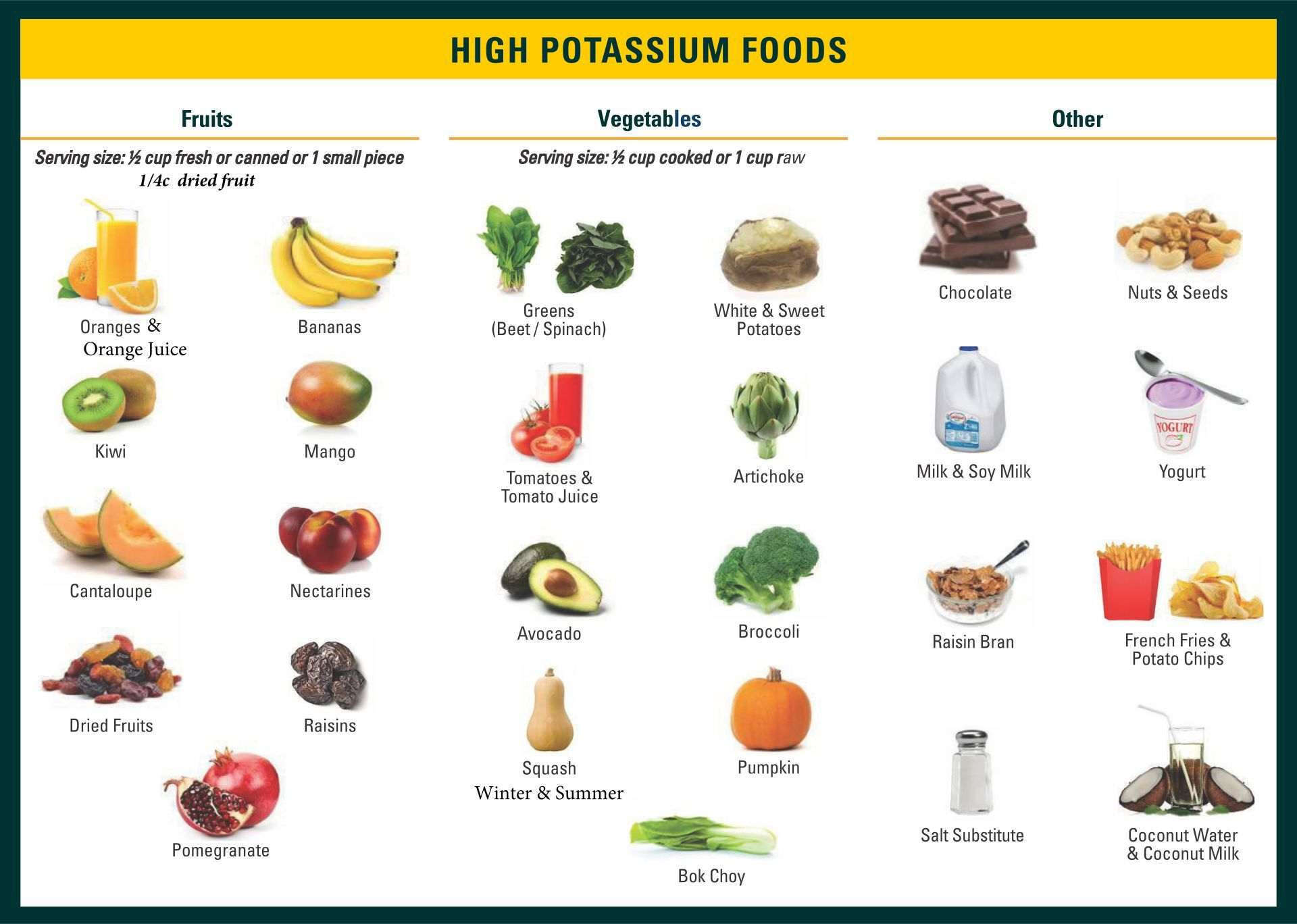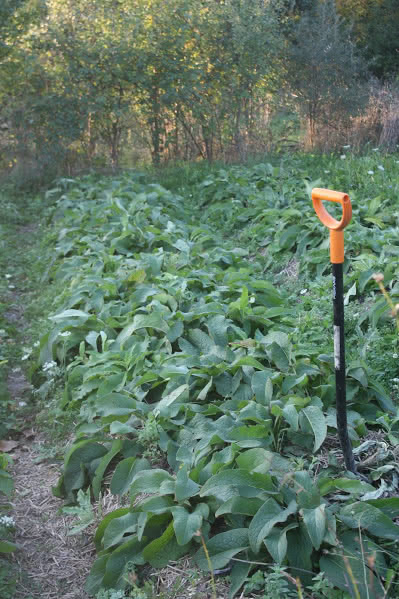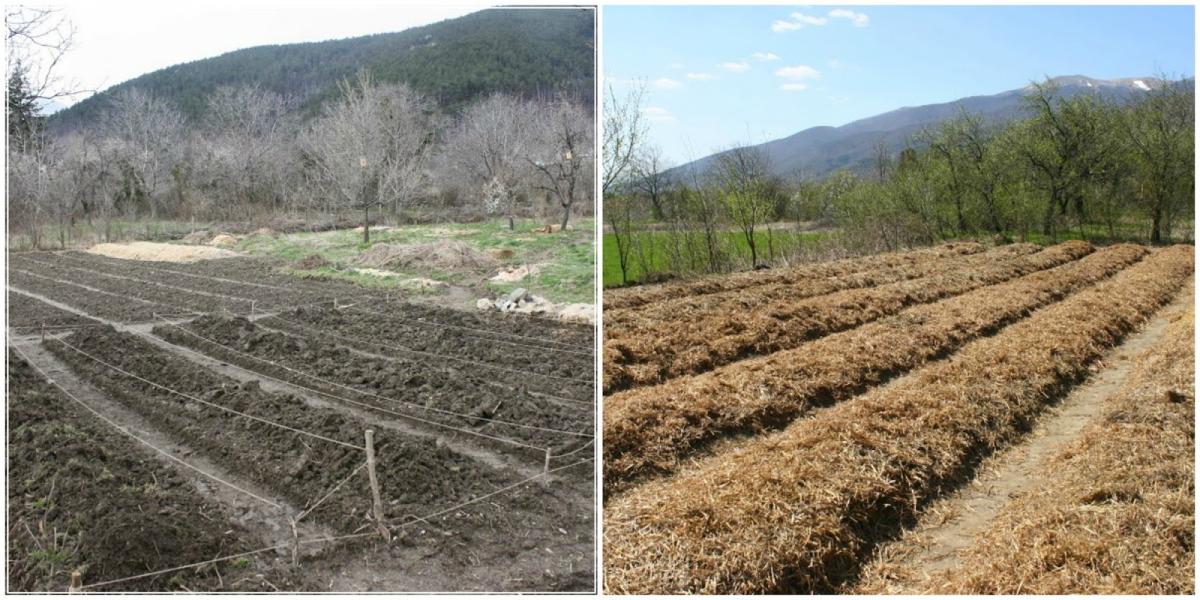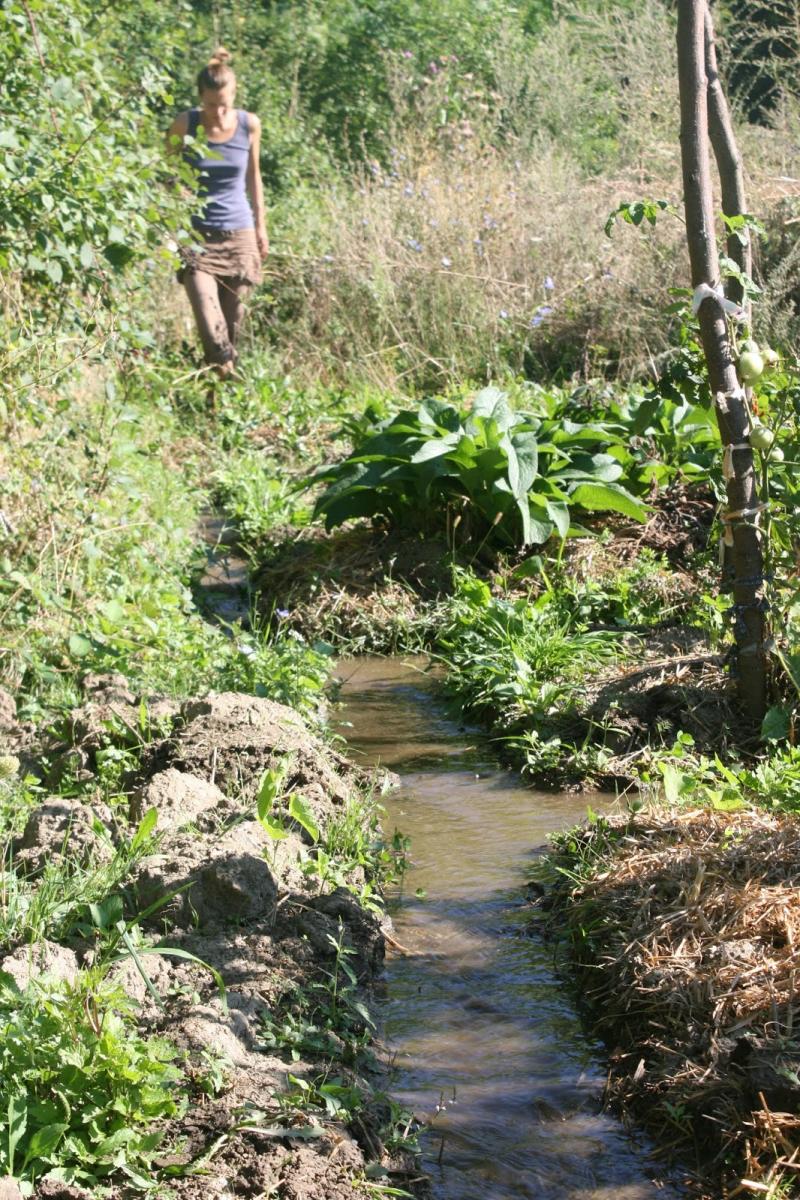There is a lot of information about comfrey, but not much about how to set up and take care of a comfrey patch. That’s why I decided to write this article to share my knowledge and explain how we grow comfrey in our market garden as part of our fertility plan.
A member of the borage family, comfrey – Symphytum spp. is native to Europe and Asia and there are 40 recorded species throughout that region. Most of the time, Russian comfrey (Symphytum x uplandicum) is used in gardens. It is a naturally occurring hybrid of two wild species: common comfrey (Symphytum officinale) and prickly comfrey (Symphytum asperum).
Several hundred years ago, Henry Doubleday (1810–1902) learned about the hybrid Symphytum x uplandicum and pushed it as a food and forage crop. Years later, and after two world wars, Lawrence D Hills (1911-1991) would continue Henry Doubleday’s Comfrey crusade.
Hills began studying comfrey in the village of Bocking, which is near Braintree in the UK, in the 1950s. The original trial site is on the plot of land now occupied by the Doubleday Gardens housing development. Lawrence Hills lived at 20 Convent Lane just around the corner of the trial site. At this site, Hills trialed at least 21 comfrey ‘strains’, each one named after the village Bocking. The most nutrient-dense strain that didn’t produce seeds was found to be Strain 14. This was the start of “Bocking 14’s” journey into gardens all over the world. (Learn more its history on the Balkan Ecology Project blog. ).
Medicinal – Comfrey has been cultivated as a healing herb since at least 400BC. Comfrey was often used by the Greeks and Romans to stop heavy bleeding, treat lung problems, and heal wounds and broken bones.
Poultices were made for external wounds and tea was consumed for internal ailments. Comfrey is said to help keep skin healthy because it contains mucilage, which soothes, moisturizes, and encourages cell growth.
This plant is my first port of call if ever I need to dress a wound. Just take a few leaves, brush them together to get rid of the hairs, and wrap them around the wound. Lightly press down on them. It’s incredibly effective at stopping the bleeding, reducing the pain and healing the wound.
Biomass: From late May (late spring) until hard frosts in October or November (late fall), comfrey grows a lot of leaves. The plant can be cut anywhere from twice to five times a year, depending on how well it is fed and watered. It makes great mulch. The plant grows rapidly after each harvest.
There is a Comfrey plant called “Bocking 14” next to every fruit tree in our gardens so that we always have mulch where we need it. As part of our plan to keep the soil healthy, we also grow in patches in the market garden and in the wildflower meadows (more on that below).
A company in Germany called Oxygenisis is trying out using this plant for carbon capture and has bought 1,000 “Bocking 14” cuttings from us.
Mineral dam: Comfrey has roots that go down up to 2 meters deep and use nutrients in the ground that other plants would have to wash away with the water in the ground or be inaccessible to them. Once the plant’s roots take in nutrients, those nutrients are moved around the plant as needed, with some ending up in the comfrey leaf mass. When the leaf mass is cut up and spread on top of the soil, the nutrients that were taken out are returned and can now be used by crop plants with shallow roots.
Different kinds of bees and other insects can get nectar and pollen from the bell-shaped flowers from late May until the first frosts in late fall. Lacewings are said to lay eggs on comfrey and spiders overwinter on the plant. Parasitoid wasps and spiders will hunt on and around comfrey.
Pest and disease control: A comfrey solution has been shown to keep powdery mildew away, according to research. Pest predators such as spiders, lacewings and parasatoid wasps associate with this plant. It’s best to leave some plants alone in order to sustain pest predator relationships.
Cover the ground: Some species can quickly grow to make a thick layer of ground cover. They do best on the sunny side of the ground under trees and shrubs. Symphytum tuberosum – Tuberous Comfrey seems to be the best species for this.
As a fertilizer, comfrey leaves have a good balance of the three main plant nutrients (N, P, and K). They can be used as mulch, as a powder, or by letting chopped comfrey leaves soak in water for a few weeks to make a thick, dark liquid that can be mixed with water and applied to plant roots. More on this below.
Comfrey’s nutritional value: The table below shows that wilted comfrey has a lot more potash than other organic fertilizers. It is well known that comfrey is a great source of potassium (K), which is a major plant nutrient that plants need in large amounts to grow and reproduce.
Animal fodder – Comfrey has a long history for use as an animal feed. Lawrence D Hills dedicated books to this topic. * The leaves are best received by animals wilted. Cows, sheep, and chickens will eat fresh leaves, but pigs, sheep, and horses will only eat wilted leaves.
Symphytum officianale and Symphytum x uplandicum are both said to be used for salads and herbs, and they taste best when they are cooked. I don’t like the texture, but I will occasionally eat something from the garden made with the new growth in a spring green salad.
Caution: Comfrey has been used as a food crop, but in the last 20 years, studies have shown that it may cause cancer because it seemed to hurt rats’ livers and grow cancerous tumors on them. These reports have temporarily restricted development of comfrey as a food crop. In light of this, the regular consumption of comfrey is not advisable.
Comfrey starts to grow in early April, and by early May, you can see tight clusters of new leaves in the crown of the old plant. Within a few weeks, the leaf blades with long petioles have grown to over 35cm high. Basal leaves are large, lance-shaped, stalked, and coarsely hairy. The leaves die back following the first frost and remain dormant for winter. Many species can spread vigorously via seed and are generally not welcome in the garden because of this. Other species can spread via tubers and all species quickly regenerate from broken root pieces.
Flowering – Starts in late May or early June and continues until the first frost in late autumn. The bell-shaped flowers with pedicels are in terminal cymes or one-sided clusters. Most common comfrey flowers are a creamy yellow color, but in Europe people have seen flowers that are white, red, or purple. Prickly comfrey has pink and blue flowers while Russian comfrey has blue, purple, or red-purple flowers. Tuberous comfrey has creamy white flowers. The plant keeps growing leaves even after it flowers, and new stems are added all the time during the growing season. Most comfrey plants can be a bit invasive, sending seeds to parts of the garden where they don’t belong. ‘Bocking 14’ will flower and provide nectar and pollen but will not produce viable seed.
Roots – Some species have short, thick, tuberous roots such as Symphytum tuberosum. Others such as Symphytum x uplandicum have deep and expansive root systems.
Moisture – Some species are drought tolerant e.g. Symphytum tuberosum. Cultivated plants require irrigation.
pH – Tolerates a wide range (6. 5-8. 5), which isn’t very sensitive to soil pH, but reports say that the best yields happen on pH 6 soils. 0 to 7. 0.
Comfrey has long been prized by gardeners for its ability to provide a powerful nutrient boost to plants. But what exactly makes this unassuming herb such a nutritional powerhouse? One of the key factors is comfrey’s exceptionally high levels of potassium.
What is Potassium and Why Do Plants Need It?
Potassium (chemical symbol K) is one of the three major macronutrients required for healthy plant growth, along with nitrogen (N) and phosphorus (P).
Potassium plays several crucial roles in plants
-
It aids in photosynthesis, the process plants use to convert sunlight into energy.
-
It helps regulate the opening and closing of the stomata, the tiny pores on plant leaves that allow air and water exchange.
-
It assists with water regulation, nutrient transport, and overall plant vigor.
-
It is vital for flower and fruit production, as well as improving color, flavor, and crop quality.
Potassium deficiency can result in weak, stunted growth and reduced yields. Providing adequate potassium ensures plants develop strong, resilient cell walls and are better able to resist disease.
Why Comfrey Leaves Are So High in Potassium
The comfrey plant is exceptional at drawing potassium up from the soil and concentrating it in its leaves and roots. Here’s why comfrey accumulates such abundant levels of potassium:
-
It has a large, dense root system that explores a wide soil area, tapping into reserves of potassium.
-
As a dynamic accumulator plant, comfrey specializes in pulling certain nutrients from the soil and storing them in soluble forms that are easily used by other plants.
-
Potassium is taken up rapidly and transported quickly to the leaves before flowering, where it gets locked in the plant tissues in readily available forms.
-
Fast, lush leaf growth in spring and summer allows comfrey to amass substantial potassium in its leaves by the time it’s ready for cutting.
Potassium Levels in Comfrey Leaves
When analyzed, comfrey leaves have been found to contain:
-
2-3% potassium in dried leaf matter.
-
Up to 4.5% potassium in fresh cut leaves.
To put this in perspective, livestock manure contains about 1-2% potassium. Wood ash contains 3-7% potassium. Comfrey leaves provide potassium levels on par with or exceeding these traditional fertilizer sources.
In practical gardening terms, the prolific leaves harvested from a comfrey plant can supply a huge amount of potassium for feeding other crops. Just a small number of comfrey plants can provide potassium-rich fertilizer for an entire garden when the leaves are converted into liquid plant feeds or used as mulch.
The Many Benefits of Comfrey as a Potassium Fertilizer
Choosing comfrey as a renewable potassium source offers many advantages:
-
Comfrey is easy and inexpensive to grow. Once established, a few plants can provide years of abundant foliage for harvesting.
-
Cutting comfrey leaves promotes rapid regrowth, allowing for multiple harvests per season.
-
Comfrey adapts readily to a variety of conditions and is trouble-free to maintain.
-
The leaves break down quickly into a nutritious plant food that can be applied directly or brewed into liquid fertilizer feeds.
-
Comfrey provides potassium in a form that is immediately usable by plants. It delivers a quick-acting potassium boost.
-
Comfrey can help gardeners reduce reliance on expensive synthetic fertilizers.
-
Fertilizing with comfrey is an organic, sustainable option that benefits the entire garden ecosystem.
For gardeners seeking to harness the nutritional powerhouse of potassium in an accessible, eco-friendly form, it’s hard to beat comfrey. This unassuming, easy-to-grow herb can enrich compost, multiply yields, and supercharge plant growth and fruiting when utilized as a unique potassium-packing fertilizer.

How we use the comfrey
As mulch: Comfrey leaves that have just been cut make good mulch because they are high in nitrogen and don’t take nitrogen from the soil as they break down. Comfrey is great for vegetables like tomatoes, peppers, and cucumbers, as well as for berries and fruit trees, because it has a lot of potassium.
With adequate feed and watering we’ve seen yields of 2-3kg of biomass per plant per cut.

Comfrey beds establishing well. This bed was planted with divided crowns 5 months prior to this photo being taken.
Liquid fertliser – What I like to call ‘Comfert’. Fill a barrel, preferably one with a bottom tap and gauze on the inside to keep it from getting clogged, with about three quarters of fresh comfrey leaves. Then add water to fill the barrel all the way to the top. Cover it, and let it steep for 3-6 weeks. The smell from the resulting liquid is far from attractive so approach with caution. The tea may be used full strength or diluted by half or more. Don’t use it before it’s going to rain a lot, because most of the nutrients in the liquid will wash right through the soil. When your vegetables need it most is when you should apply the feed for the best results. This will be different for each plant. For example, tomatoes should be fed when they are setting fruit and afterwards at any time while they are fruiting. Applying comfert before this can be counter productive and make your plants more susceptible to pest problems. The black slurry at the bottom of the barrel can be dispersed evenly back over the comfrey patch.
You can also make “Comfert Plus,” a liquid fertilizer concentrate, by putting fresh-cut comfrey tops into an old bucket, putting something heavy on top of them, and sealing the lid tightly. Then, wait a few weeks, and the tops will break down into a black slurry. By making a hole in the bottom of the bucket, you can catch the concentrate as it drips into another pitcher. Dilute this comfrey concentrate about 15 to 1 with water, and use as you would comfert. You can seal this concentrate in plastic jugs until you are ready to use it.
Warning! Comfert stinks like hell. My nieces came to visit from London last year and offered to help out in the market garden. One of the tasks that day was to apply comfert to the crops. Simply put, things did not go as planned. The next day, we had a much better time cutting down softwood trees.
Setting up a comfrey patch
You might want to grow comfrey to feed your animals, make medicine, use as mulch or compost, or maybe you’re a bit of a masochist and want to roll around naked in the sharp beds of biomass (not me). In any case, here’s how to do it.
The plant we use in our gardens is Symphytum x uplandicum – ‘Bocking 14’. A sterile cultivar that produces copious quantities of nutrient dense biomass. The following information is based on using this plant.
What site to use? We’re growing for biomass, so we want the plants to get as much light as possible. Accordingly, we lay out our beds on an east to west axis (we’re in the northern hemisphere).
To get good crop yields from plants, you need to water them, so choosing a spot that can be irrigated is very important.
In places where it doesn’t rain much, using the slope of the land to direct rainwater toward your beds will make your plants need less water. If it rains a lot and the water table is high, you might want to move the water away from the beds.
Once it starts to grow, comfrey is hard to get rid of, so pick a spot where you want it to stay. If you want to grow crops, don’t plant comfrey there because the broken roots will grow new plants quickly and beat out slower-growing crops.
Position comfrey downhill from where you expect leachate to be present, i. e downhill from a manure pile , compost heap, outside toilet, animal pen etc. can give plants passive fertility and keep minerals from being washed away with the groundwater Grow the comfrey where you want to use it. We may be taking more than 1/4 ton of biomass from our patch, and we don’t want to have to carry that over long distances, as you’ll see later.
Getting the site ready: raised beds are a big part of our fertility plan because they hold water and nutrients very well over time. I use 1. We grow our crops in 3m-wide beds surrounded by 50cm paths. This makes it easy to harvest from anywhere in the beds without having to step on the soil, and the paths are wide enough for our lawnmower.
First, get rid of all the plants in the area. This can be done best by sheet mulching the area the year before. Pernicious perennials or tap rooted biennials should be dug out. When you’re done clearing the area, use string to make the shape of the beds and dig 50 cm wide paths around them. Spread soil over the planting area to make the bed’s first rise. Fork over the beds well. If a hardpan is present take the time and effort to eliminate it before planting.

Depending on how good your soil is, you might need to add more compost to the bed before you plant. With the extra soil from the paths, all you need to do is add a 20 cm layer of straw mulch (or another mulch) if you have already sheet mulched the area. Then it’s ready to plant. A good mulch to start with will help keep the weeds down while your comfrey gets going.
You can alter the depth and gradient of the paths to facilitate the required direction of water movement.
Plant material: You can plant crown divisions or root cuttings outside. It’s best to do this in the spring, when the soil is warm. Putting a spade through the middle of a mature comfrey plant and transplanting the split sections will give you a crown division. I cut two-year-old plants into quarters or sometimes sixths for our beds, and they did really well in their first year. This is the first year that you shouldn’t harvest the leaf biomass because you want the roots to grow deep. However if you use large divisions you can start harvesting in July.
Root cuttings are a great way to plant out large areas of comfrey. The cuttings should be grown in small pots with a mix of compost and river sand that is kept moist. They should be planted outside in the spring as soon as the first leaves appear and the soil has warmed up. You can plant a lot of root cuttings directly into the beds by making “nests” in the straw and adding two cups’ worth of the potting mix above. Then, plant the cuttings in these “nests.” Keep them moist like a wrung out sponge and the success rate will be very close to 100%.
Spacing – The plants should be spaced 60cm apart in rows and 60cm apart at diagonals between rows. Plant the rows 15cm from the edge of the beds.
Cutting—Let the plants get established the first year so that the roots can grow well and go deep into the soil. Remove any weeds around the plants leaving them on the surface. The following year the cutting can begin. For a quick harvest, you can scythe the beds, or you can use secateurs or shears to cut each plant off at the base, about 5 cm from the ground.
The leaves are prickly so if you have sensitive hands wear gloves. Cut the comfrey as the flowering stalks emerge up to four times a year. Native bees and honey bees will find food on the plants if you let them flower at least once during the season. Do not cut off the last few leaves before winter. This will allow insects to find shelter in the undergrowth. Every once in a while, you may need to pull weeds between cuts, but the comfrey will quickly cover the ground.
When you’re done cutting the comfrey, mow the paths between the beds and dump the grass clippings at the base of the comfrey plants. Any trimmings from lawns and hedges in the surrounding area can also be used.
We are trying growing nitrogen-fixing hedges and ground cover plants next to the patch to see how they work for feeding our comfrey.
Undiluted urine, applied at a rate of about 500 ml per plant twice a year, is a great food for comfrey.
Irrigation – Comfrey will produce more biomass if irrigated and in dry climates it’s essential to irrigate. Comfrey plants wilt very fast in hot conditions and will stop photosynthesising at this point. Twenty litres per m2 per week of drought should be more than adequate. If you take care of biological systems the right way, the soil gets better every year, and over time it will be better at holding water.
We use passive irrigation diverting water from a mountain stream into the paths around the beds. The paths fill with water, and we raise the level by putting sacks of sawdust over low spots to block them. The water is then drawn through the soil by capillary action.

Passive irrigation in our market garden. The paths fill with water and the water permeates throughout the soil via capillary action.
Turn Comfrey Leaves into a FREE High Potassium Plant Food | How to make Comfrey Tea to feed Plants
FAQ
How much potassium is in comfrey?
Who should not use comfrey?
What is comfrey feed high in?
What is comfrey rich in?
- A Complete Guide to Caring for Yuki Cherry Blossom Shrub - January 23, 2025
- Identifying Red Hot Poker Seeds: What to Look For When Harvesting Torch Lily Pods - January 23, 2025
- A Complete Guide to Harvesting Evening Primrose Seeds - January 23, 2025
